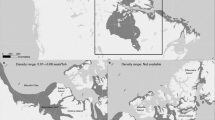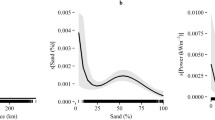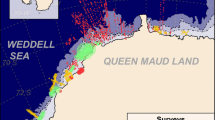Abstract
The Wadden Sea is an important habitat for harbour seals and grey seals. They regularly haul-out on sandbanks and islands along the coast. Comparably little is known about the time seals spend at sea and how they use the remainder of the North Sea. Yet, human activity in offshore waters is increasing and information on seal distribution in the North Sea is crucial for conservation and management. Aerial line transect surveys were conducted in the German bight from 2002 to 2007 to investigate the distribution and abundance of marine mammals. Distance sampling methodology was combined with density surface modelling for a spatially explicit analysis of seal distribution in the German North Sea. Depth and distance to coast were found to be relevant predictor variables for seal density. Density surface modelling allowed for a depiction of seal distribution in the study area as well as an abundance estimate. This is the first study to use aerial survey data to develop a density surface model (DSM) for a spatially explicit distribution estimate of seals at sea.




Similar content being viewed by others
Notes
In this context, group is defined as a number of animals engaged in similar behaviour, not to be confused with a “social group” as found with e.g. cetaceans.
Animal positioned vertically in the water column with its head out of the water.
References
Aarts G, MacKenzie M, McConnell B, Fedak M, Matthiopoulos J (2008) Estimating space-use and habitat preference from wildlife telemetry data. Ecography 31:140–160. doi:https://doi.org/10.1111/j.2007.0906-7590.05236.x
Adelung D, Kierspel MAM, Liebsch N, Müller G, Wilson RP (2006) Distribution of harbour seals in the German bight in relation to offshore wind power plants. In: Köller J, Köppel J, Peters W (eds) Offshore wind energy. Research on environmental impacts. Springer, Heidelberg, pp 65–75
Akaike H (1973) Information theory and an extension of the maximum likelihood principle. In: Petrov BN, Csa`aki F (eds) Second international symposium on information theory. Akademiai Kiado, Budapest, pp 267–281
Austin D, Bowen WD, McMillan JI, Iverson SJ (2006) Linking movement, diving and habitat to foraging success in a large marine predator. Ecology 87:3095–3108. doi:https://doi.org/10.1890/0012-9658(2006)87[3095:LMDAHT]2.0.CO;2
Barlow J, Oliver CW, Jackson TD, Taylor BL (1988) Harbour porpoise, Phocoena phocoena, abundance estimation for California, Oregon, and Washington: II. Arial surveys. Fish Bull 86:433–444
Bekkby T, Bjørge A (2000) Diving behaviour of harbour seal Phoca vitulina pups from nursing to independent feeding. J Sea Res 44:267–275. doi:https://doi.org/10.1016/S1385-1101(00)00048-4
Bolnick DI, Svanback R, Fordyce JA, Yang LH, Davis JM, Husley CD, Forister ML (2003) The ecology of individuals: incidence and implications of individual specialization. Am Nat 161:1–28. doi:https://doi.org/10.1086/343878
Brasseur S, Creuwels J, v/d Werf B, Reijnders P (1996) Deprivation indicates necessity for haul-out in harbour seals. Mar Mamm Sci 12:624–627. doi:https://doi.org/10.1111/j.1748-7692.1996.tb00077.x
Buckland ST, Anderson DR, Burnham KP, Laake JL, Borchers DL, Thomas L (2001) Introduction to distance sampling: estimating abundance of biological populations. Oxford University Press, London
Burnham KP, Anderson DR (2002) Model selection and multimodel inference: a practical information-theoretic approach. Springer, Berlin
Burnham KP, Buckland ST, Laake JL, Borchers DL, Marques TA, Bishop JRB, Thomas L (2004) Further topics in distance sampling. In: Buckland ST, Anderson DR, Burnham KP, Laake JL, Borchers DL, Thomas L (eds) Advanced distance sampling: estimating abundance of biological populations. Oxford University Press, New York, pp 307–392
CWSS (1992). Sixth trilateral Governmental Wadden Sea Conference 1991. Ministerial declaration—seal conservation and management plan. Common Wadden Sea Secretariat, Wilhelmshaven, Germany, p 55
EEC (1992) Council Directive 92/43/EEC of 21 May 1992 on the conservation of natural habitats and of wild fauna and flora. http://eur-lex.europa.eu/LexUriServ/LexUriServ.do?uri=CELEX:31992L0043:EN:HTML
Efron B, Tibshirani RJ (1993) An introduction to the bootstrap. Chapman & Hall, New-York
Ehrich S, Kloppmann MHF, Sell AF, Boettcher U (2006) Distribution and assemblages of fish in German waters. In: Koeller J, Koeppel J, Peters W (eds) Offshore wind energy. Springer, Berlin, pp 149–180
Estes JA, Riedman ML, Staedler MM, Tinker MT, Lyon BE (2003) Individual variation in prey selection by sea otters: patterns, causes and implications. J Anim Ecol 72:144–155. doi:https://doi.org/10.1046/j.1365-2656.2003.00690.x
Fedak MA, Pullen MR, Kanwisher J (1988) Circulatory responses of seals to periodic breathing: heart rate and breathing during exercise and diving in the laboratory and open sea. Can J Zool 66:53–60
Garthe S, Dierschke V, Weichler T, Schwemmer P (2004) Rastvogelvorkommen und Offshore-Windkraftnutzung: Analyse des Konfliktpotenzials für die deutsche Nord- und Ostsee. In: Kellermann A, et al (eds) Marine Warmblüter in Nord- und Ostsee: Grundlagen zur Bewertung von Windkraftanlagen im Offshore-Bereich. Endbericht
Hammond PS, Benke H, Berggren P, Borchers DL, Buckland ST, Collet A, Heide-Jørgensen MP, Heimlich-Boran S, Hiby AR, Leopold MF, Øien N (1995) Distribution and abundance of harbour porpoises and other small cetaceans in the North Sea and adjacent waters. European Community LIFE programme, Life, LIFE 92-2/IL/027, p 242
Härkönen TJ, Dietz R, Reijnders P, Teilmann J, Harding K, Hall A, Brasseur S, Siebert U, Goodman SJ, Jepson PD, Rasmussen TD, Thompson P (2006) A review of the 1988 and 2002 phocine distemper virus epidemics in European harbour seals. Dis Aquat Org 68:115–130. doi:https://doi.org/10.3354/dao068115
Hastie TJ, Tibshirani RJ (1990) Generalized additive models. Chapman & Hall, London
Hedley SL, Buckland ST (2004) Spatial models for line transect sampling. J Agric Biol Environ Stat 9:181–199. doi:https://doi.org/10.1198/1085711043578
Hedley SL, Buckland ST, Borchers DL (2004) Spatial distance sampling models. In: Buckland ST, Anderson DR, Burnham KP, Laake JL, Borchers DL, Thomas L (eds) Advanced distance sampling: estimating abundance of biological populations. Oxford University Press, New York, pp 48–70
Hiby AR, Hammond PS (1989) Survey techniques for estimating the abundance of cetaceans. Rep Int Whal Comm Spec Issue 11:47–80
Krafft BA, Lydersen C, Gjertz I, Kovacs KM (2002) Diving behaviour of sub-adult harbour seals (Poca vitulina) at Prins Karls Forland Svalbard. Polar Biol 25:230–234. doi:https://doi.org/10.1007/s00300-001-0330-2
Judson OP (1994) The rise of the individual-based model in ecology. Trends Ecol Evol 9:9–14
Leopold MF, v/d Werft B, Ries EH, Reijnders PJH (1997) The importance of the North Sea for winter dispersal of harbour seals Phoca vitulina from the wadden sea. Biol Conserv 81:97–102. doi:https://doi.org/10.1016/S0006-3207(96)00092-4
Liebsch NS (2006) Hankering back to ancestral pasts: constraints on two pinnipeds, Phoca vitulina & Leptonychotes weddellii foraging from a central place. Ph.D. Thesis, University of Kiel, p 161
Liebsch N, Wilson RP, Adelung D (2006) Utilisation of time and space by harbour seals (Phoca vitulina vitulina) determined by new remote-sensing methods. In: von Nordheim H, Boedeker D, Krause JC (eds) Progress in marine conservation in Europe: NATURA 2000 sites in German offshore waters. Springer, Berlin, pp 178–188
Madsen PT, Wahlberg M, Tougaard J, Lucke K, Tyack P (2006) Wind turbine underwater noise and marine mammals: implications of current knowledge and data needs. Mar Ecol Prog Ser 309:279–295. doi:https://doi.org/10.3354/meps309279
Marques FFC, Buckland ST (2003) Incorporating covariates into standard line transect analyses. Biometrics 59:924–935. doi:https://doi.org/10.1111/j.0006-341X.2003.00107.x
Matthiopoulos J, McConnell B, Duck C, Fedak M (2004) Using satellite telemetry and aerial counts to estimate space use by grey seals around the British Isles. J Appl Ecol 41:476–491. doi:https://doi.org/10.1111/j.0021-8901.2004.00911.x
Pollock KH, Nickels JD, Simons TR, Farnsworth GL, Bailey LL, Sauer JR (2002) Large scale wildlife monitoring studies: statistical methods for design and analysis. Environmetrics 13:105–119. doi:https://doi.org/10.1002/env514
Reijnders PJH (1976) The harbour seal Phoca vitulina population in the Dutch Wadden Sea: size and composition. Neth J Sea Res 10:223–235. doi:https://doi.org/10.1016/0077-7579(76)90016-8
Reijnders PJH (1992) Retrospective population analysis and related future management perspectives for the harbour seal Phoca vitulina population in the Wadden Sea. Netherlands Institute for Sea Research. Spec Publ Ser 20:193–197
Reijnders PJH, Ries EH, Tougaard S, Norgaard N, Heidemann G, Schwarz J, Vareschi E, Traut IM (1997) Population development of harbour seals Phoca vitulina in the Wadden Sea after the 1988 virus epizootic. J Sea Res 38:161–168. doi:https://doi.org/10.1016/S1385-1101(97)00031-2
Reijnders PJH, Abt KF, Brasseur SMJM, Camphuysen KCJ, Reineking B, Scheidat M, Siebert U, Stede M, Tougaard J, Tougaard S (2005) Marine mammals. In: Essink K, Dettmann C, Farke H, Laursen K, Lürßen G, Marencic H, Wiersinga W (Trilateral Monitoring and Assessment Group) (eds) Wadden Sea Quality Status Report 2004. Wadden Sea Ecosystem No.19. Common Wadden Sea Secretariat, Wilhelmshaven, pp 305–318
Ries EH (1993) Monitoring the activity patterns of free-ranging harbor seals (Phoca vitulina) by means of VHF telemetry. Wadden Sea Newsl 3:11–14
Seber GAF (1982) The estimation of animal abundance and related parameters. Griffin, London
Siebert U, Wohlsein P, Lehnert K, Baumgärtner W (2007) Pathological findings in harbour seals (Phoca vitulina): 1996–2005. J Comp Pathol 137:47–58. doi:https://doi.org/10.1016/j.jcpa.2007.04.018
R Development Core Team (2006) R: a language and environment for statistical computing. R Foundation for Statistical Computing, Vienna, Austria. ISBN 3-900051-07-0, http://www.R-project.org
Thomas L, Laake JL, Strindberg S, Marques FFC, Buckland ST, Borchers DL, Anderson DR, Burnham KP, Hedley SL, Pollard JH, Bishop JRB, Marques TA (2006) Distance 6.0. beta. Research unit for wildlife population assessment, University of St. Andrews, http://www.ruwpa.st-and.ac.uk/distance/
Thompson PM, Harwood J (1990) Methods for estimating the population size of common seals, Phoca vitulina. J Appl Ecol 27:924–938. doi:https://doi.org/10.2307/2404387
Thompson PM, Miller D (1990) Summer foraging activity and movements of radio-tagged common seals (Phoca vitulina L.) in the Moray Firth, Scotland. J Appl Ecol 27:492–501. doi:https://doi.org/10.2307/2404296
Thompson PM, Miller D, Cooper R, Hammond PS (1994) Changes in the distribution and activity of female harbour seals during the breeding season: implications for their lactation strategy and mating patterns. J Appl Ecol 63:24–30
Thompson PM, McConnell BJ, Tollit DJ, Mackay A, Hunter C, Racey PA (1996) Comparative distribution, movements and diet of harbour and grey seals from the Moray Firth. N.E. Scotland. J Appl Ecol 33:1572–1584. doi:https://doi.org/10.2307/2404795
Thompson PM, Tollit DJ, Wood DG, Corpe HM, Hammond PS, Mackay A (1997) Estimating harbour seal abundance and status in an estuarine habitat in N.E. Scotland. J Appl Ecol 34:43–52. doi:https://doi.org/10.2307/2404846
Thompson PM, Mackay A, Tollit DJ, Enderby S, Hammond PS (1998) The influence of body size and sex on the characteristics of harbour seal foraging trips. Can J Zool 76:1044–1053. doi:https://doi.org/10.1139/cjz-76-6-1044
Tougaard J, Ebbesen I, Tougaard S, Jensen T, Teilmann J (2003) Satellite tracking of harbour seals on Horns Reef. Use of the wind farm area and the North Sea. Report to Techwise A/S
Tougaard J, Tougaard S, Jensen RC, Jensen T, Adelung D, Liebsch N, Müller G (2006) Harbour seals on horns reef before, during and after construction of horns rev offshore wind farm. Final report to Vattenfall A/S. Biological Papers from the fisheries and maritime museum No. 5. Esbjerg, Denmark
Tougaard J, Teilmann J, Tougaard S (2008) Harbour seal spatial distribution estimated from argos satellite telemetry—overcoming positioning errors. Endanger Species Res 4:113–122. doi:https://doi.org/10.3354/esr00068
TSEG (Trilateral Seal Expert Group) (2003). Sense and sensibility in evaluating aerial counts of harbour seals in the Wadden Sea. Wadden Sea Newsletter, Wilhelmshaven, http://www.waddensea-secretariat.org/news/publications/Wsnl/Wsnl03-1/articles/4-seal-counts.pdf
TSEG (Trilateral Seal Expert Group) (2006) Aerial surveys of harbour seals in the Wadden Sea in 2006: puzzling results and counting grey seals in the Wadden Sea in 2006. Wadden Sea Newsletter, Wilhelmshaven, http://www.waddensea-secretariat.org/news/news/Seals/Annual-reports/Annual-counts-2006.pdf
TSEG (Trilateral Seal Expert Group) (2008a). Annual Reports. Wadden Sea Newsletter, Wilhelmshaven, http://www.waddensea-secretariat.org/news/news/Seals/Annual-reports/seals2007.html
TSEG (Trilateral Seal Expert Group) (TSEG) (2008b) Aerial surveys of harbour seals in the Wadden Sea in 2007: population age-composition returning to a stable age-structure? Wadden Sea Newsletter, Wilhelmshaven, http://www.waddensea-secretariat.org/news/news/Seals/Annual-reports/Annual-counts-2007-seals.pdf
Van Parijs SM, Thompson PM, Tollit DJ, Mackay A (1997) Changes in the distribution and activity of male harbour seals during the mating season. Anim Behav (in press)
Wadden Sea Secretariat (2008) http://www.waddensea-secretariat.org/. Accessed October 2008
Wood SN (2006) Generalized additive models: an introduction with R. Chapman & Hall/CRC, Florida
Acknowledgments
The data analysed for this work was collected in several projects funded by the German Federal Agency for Nature Conservation (BfN), the German Federal Ministry of Food, Agriculture and Consumer Protection (BMELV) and the German Federal Ministry for the Environment, Nature Conservation and Nuclear Safety (BMU). We would like to thank Anita Gilles for helpful discussion and Geert Aarts for valuable criticism of an earlier draft. We owe thanks to Kristin Kaschner and Hauke Giewat for their assistance with the database. Our thanks also go to the pilots, from Sylt Air, the Danish Air Survey and FLM Kiel as well as to our enthusiastic observer team.
Author information
Authors and Affiliations
Corresponding author
Additional information
Communicated by U. Sommer.
Rights and permissions
About this article
Cite this article
Herr, H., Scheidat, M., Lehnert, K. et al. Seals at sea: modelling seal distribution in the German bight based on aerial survey data. Mar Biol 156, 811–820 (2009). https://doi.org/10.1007/s00227-008-1105-x
Received:
Accepted:
Published:
Issue Date:
DOI: https://doi.org/10.1007/s00227-008-1105-x




